|
What
Mammals might you find in a hedge?
Birds | Butterflies |
Insects | Mammals
|
Mammals by
thehedge.org
In this
section, you will find some interesting information about mammals, that is the
animals that you might find in hedges and similar areas. |
| These animals
are listed in alphabetical order:
|
| Badger |
 |
About the
Badger:
The Badger is one of the most easily recognised of our mammals,
having a white head a dark stripe on either side which includes the eye.
Badgers are the largest of our woodland animals. The badger’s burrow is
called a “Sett”. The badger has short, strong legs, long feet where
the heels touch the ground, straight strong toes adapted to burrowing. They
live in dense undergrowth and are mostly nocturnal. It eats fruits, roots,
beechnuts, eggs, young birds, small frogs, snails and insects and it also feeds
on honey and on larvae of wasps and wild bees. The shaggy hair of the badger is
to protect it against stings. |
| Bat -
Daubenton's Bat |
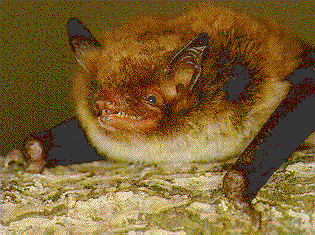 |
About the Daubenton's
Bat:
This is a small species, with a pinkish-brown face and large feet.
The fur on their upperparts is dark grey/brown and the underparts are silvery
grey. The wings and tail membrane are dark brown. They like to live in wooded
country, often near water. They hunt over the open water and around trees,
preying on small flying insects such as mosquitoes, gnats and moths. They
hibernate from September to April and there may be several thousand individuals
in one colony. During the summer they roost in tree holes and attics, and in
the winter they roost in caves, tunnels and cellars. They leave their roosts to
hunt at twilight, and they are fast agile fliers. |
| Bat -
Leisler's Bat |
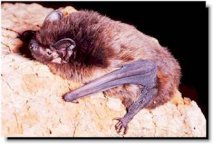 |
About the Leisler's
Bat:
Leisler's Bat is the largest bat found in Ireland. Ireland is
probably their European stronghold. It is thickly furred, dark brown with a
mammal face. The ears are large and broad and have a club-shaped element. They
roost in dense groups in attics but hibernate in holes in trees as well as in
ruins. They hibernate from mid-November to March. In flight they have a high
metabolic rate and must eat a lot. This is a problem because maintaining a high
body temperature can be difficult when food is scarce. They therefore save
energy when necessary by lowering body temperature and not moving
about. |
| Bat -
Lesser-Horseshoe Bat |
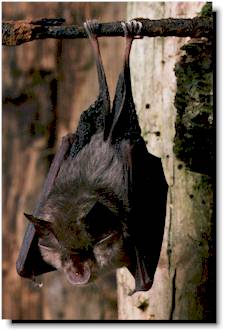 |
About the
Lesser-Horseshoe Bat:
The Lesser-Horseshoe Bat is about as big as a
plum and is one of the smaller species. They roost in old buildings in
sheltered valleys with deciduous woodland, including hedges. It is found West
of the Shannon, in North Co. Clare. They hunt close to riverside vegetation and
in dense vegetation. They come out of their roosts about an hour before sunset.
They like to eat craneflies i.e.' daddy-longlegs', caddis flies, moths and
lacewings. They use a low range of ultrasound between 105 and 115 kHz to locate
their prey. Their complex nose leaves are used as a reflector to alter the
shape of the sound beam. |
| Bat -
Natterer's Bat |
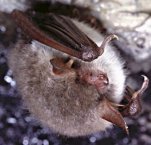 |
About the Natterer's
Bat:
The Natterer's Bat can weigh up to 12g in autumn and their weight
then declines in Winter to 7g. They are very small with a broad wingspan of
21cm to 24cm. They are very rare and are a forest or woodland animal, roosting
in tree-holes. Their summer roosts are in old buildings.They come out to hunt
about an hour after sunset and fly around trees or in the woodland canopy. They
catch insects such as caddis flies and moths in the air and pick resting
insects off the leaves of trees which is known as 'gleaning'. |
| Bat -
Pipistrelle Long-Eared Bat |
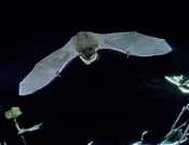 |
About the Pipistrelle
Long-Eared Bat:
Their Irish name is Laltog Fheascrach which means 'bat
of the evening'. It is our most common bat since records began to be collected
in the 19th century. It is Ireland's second smallest bat, after the
Natterer’s bat. Its teeth are long and very sharp, great for piercing the
tough outer skeleton of insects. They come out at dusk from roosts near woods
or hedgerows, because in shaded areas the poorer light make them more difficult
to be seen. Barn and long-eared owls hunt them. When feeding really well, they
may catch 15 insects a minute and may eat up to 3500 insects in one night.
Their roost site, usually in an old building, must be close to trees, woods or
hedgerows. |
| Bat -
Whiskered Bat |
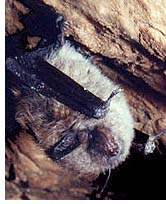 |
About the Whiskered
Bat:
The Irish name Giobach means 'shaggy'. It is a very rare mammal but
has a particular connection to hedges as it hunts along hedges, over open
deciduous and coniferous woodland and in scrub areas. They catch small insects
such as moths in the air and 'glean' small insects and spiders off leaves. In
summer they roost in houses, in winter they hibernate in hollow trees or in
cavities in old buildings. They may be active all night and return to their
roost only at dawn. |
Back to
Index Page | Next Page of
Mammals |

